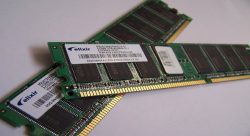 Often, you are in a situation when your desktop system is not stable and you want to test the RAM for problems. You have two options to test the RAM for problems. One option is to use a hidden system memory diagnostic tool included in Windows. The second option is to download a powerful testing tool and use that. Both of them work by writing data on a sector of the system’s RAM and reading it after that. If the tool reads a value that is different from the value that was written, then it means that your RAM has some problems that need to be fixed.
Often, you are in a situation when your desktop system is not stable and you want to test the RAM for problems. You have two options to test the RAM for problems. One option is to use a hidden system memory diagnostic tool included in Windows. The second option is to download a powerful testing tool and use that. Both of them work by writing data on a sector of the system’s RAM and reading it after that. If the tool reads a value that is different from the value that was written, then it means that your RAM has some problems that need to be fixed.
Test the RAM for problems by Running the Windows Memory Diagnostic Tool
To use the Windows Memory Diagnostic tool, click the Start menu and in the Search box, you should enter “Windows Memory Diagnostic” and hit Enter. You can also click the Start menu and click Run and in the Run dialog box type “mdsched.exe” and press Enter. It is not possible to work on your computer when the test is running. So, you need to select the option “Restart now and check for problems (recommended).” Before restarting, you should save and close all the open programs.
Now, your computer will restart and the Diagnostic tool will start running the test. The status message will display the problems detected during the test. A progress bar displays the progress percentage of the process. The test will take some time to complete. After the test is completed, your system will reboot automatically. With most systems, the results of the test will be displayed once your system restarts and you log in. This is one way to test the RAM for problems.
How to See the Windows Memory Diagnostic Tool Test Results if it is Not Displayed Automatically
In some operating systems like Windows 10, the test results are not displayed automatically when you login. So, launch the Windows Event Viewer by typing “Event Viewer” into your Start menu Search box OR open the Event Viewer by right clicking on the Start button.
On Windows 7, you must use Windows key + R to open the Run dialog and then enter “eventvwr.msc” and hit Enter. There, browse to System in Windows Logs to view the list of events. Then, click on Find in Actions section. Enter “MemoryDiagnostic” and click on “Find Next”. Results are displayed in the window.
Test the RAM for Problems by Booting and Running MemTest86
MemTest86 is more powerful than the system memory diagnostic tool used to test the RAM for problems as it can detect a range of problems associated with your system. The free version can do the job well. MemTest86 is bootable and creates a USB image that can be copied to any USB drive. It also creates an ISO image, if required, so you can burn the ISO image to a CD/DVD. Then, the next step is to run the .exe file from the download and create a bootable USB drive. Please note that all the files in the drive will be deleted. Now, the bootable media is ready. Restart the computer and boot from your USB drive (or the CD/DVD).
MemTest86 will boot, scan the RAM and run different tests and report on your screen if there is any problem. The process will continue till you stop the test. This helps you to identify if any changes occur in RAM over an extended period of time. To exit the test, you just hit the “Escape” key and restart your PC.
Conclusion
Sometimes, the RAM may have to be replaced if the memory tests display errors. At other times, the problem may be because the RAM is incompatible with your motherboard or the RAM may not be able to run at the present speed. You should make the required changes and after that run the programs again to test the RAM for problems.

 Email article
Email article



